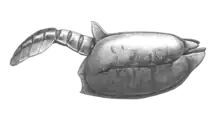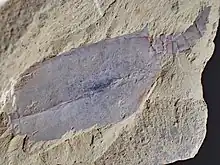Vetulicola cuneata
Vetulicola cuneata ("wedged-shaped ancient dweller") is a species of extinct animal from the Early Cambrian Chengjiang biota of China. It was described by Hou Xian-guang in 1987 from the Lower Cambrian Chiungchussu Formation,[1][2] and became the first animal (type species) under an eponymous phylum Vetulicolia.[3]
| Vetulicola cuneata Temporal range: | |
|---|---|
 | |
| Reconstruction of V. cuneata | |
| Scientific classification | |
| Domain: | Eukaryota |
| Kingdom: | Animalia |
| Phylum: | †Vetulicolia |
| Class: | †Vetulicolida |
| Order: | †Vetulicolata |
| Family: | †Vetulicolidae |
| Genus: | †Vetulicola |
| Species: | †V. cuneata |
| Binomial name | |
| †Vetulicola cuneata Hou, 1987 | |
Remarked as "enigmatic creatures"[4] and originally classified as an arthropod, it is recognised as a deuterostome along with other related species, for which a separate class (Vetulicolida), order (Vetulicolata), family (Vetulicolidae) and ultimately a new phylum were created based on its name.[3][5]
Discovery and taxonomy
In 1984, Hou Xian-guang of the Nanjing Institute of Geology and Palaeontology, Chinese Academy of Sciences, explored the Chiungchussu Formation in Chengjiang, China. At the Maotianshan Hill, from which the sediments called Maotianshan Shales were already established to be of Cambrian in origin,[6] he found a variety of animal fossils. The first species he formally reported was that of an arthropod Naraoia, described as an "unusual trilobite".[7] The rich fossils were eventually established as the Chengjiang biota.[8]
Among Hou's earliest collections were a group of bivalved arthropods, which he described in the journal Acta Palaeontologica Sinica in 1987.[2] One group which he categorised "larger bivalved arthropods" included five distinct species, one of which he named Vetulicola cuneata,[1] for its obvious ancient nature (Latin vetuli means "old" and cola, "inhabitant") and wedge-shaped beak-like body (cuneata for wedge-shaped).[4] Although Hou classified V. cuneata as a species of the phylum Arthopoda for its prominent body covering called carapace, a common feature among arthropods, he immediately noticed some issues. The Vetulicola body was divided into two separate parts, dorsal and ventral carapace, by clear longitudinal groove, which he realised was an odd feature for an arthropod that should normally lack such demarcating groove. He also mistakenly identified a short tail-like projection at the posterior region as consisting of two segments and attached to the ventral side of the body.[9]
In 1991, with the help of Jan Bergström (of the Swedish Museum of Natural History), Hou re-analysed the species from more than 100 specimens and resolved that the posterior projection typically consists of seven segments and arose (after turning upside-down the specimens) from the dorsal surface of the body.[10] Palaeontologists continued to consider the species as an arthropod although they understood the anomaly and missing features of Arthropoda.[11][12][13]
In 1997, Hou's colleagues Jun-yuan Chen and Guiqing Zhou extensively reviewed and re-eaxmined the Chengjian fossils. Among the new species they identified was Banffia confusa.[14] The genus Banffia was created by American palaeontologist Charles Doolittle Walcott in 1911 for a new species B. constricta from the Burgess Shale of British Columbia, Canada.[15] B. constricta was considered as member of the phylum Annelida for its apparent segmented worm-like body.[16] When Chen and Zhou compared B. confusa with V. cuneata, they realised the close relationship between the two specimens, having shared most defining features, so that they created a new class Vetulicolida for the two genus under Arthropoda.[9][17]
In 1999, Huilin Luo and his colleagues at the Yunnan Institute of Geological Sciences described a new species Pomatrum ventralis as a closely related arthropod to V. cuneata.[9][18] The same year, Degan Shu and his research team at the Northwest University in Xi'an, along with Simon Conway Morris at the University of Cambridge, described a new species Xidazoon stephanus which was recognised as related to primitive jawless fish.[19] In 2001, Shu and Conway Morris realised the need to reassess all the Chengjian species related to V. cuneata. With a report of a new species Didazoon haoae, they revised the entire classification adopting the class Vetulicolida and introduced the phylum Vetulicolia for all species of Vetulicola, Banffia, Pomatrum, Xidazoon and Didazoon. The new phylum was classified as member of the "primitive deuterostomes," a group that consists of animals ancestral to chordates.[5][20]
Description

Vetulicola cuneata has a body composed of two distinct parts of approximately equal length.[1] The anterior part is rectangular in shape, and enclosed by a carapace-like structure of cuticular plates fused together, with a large, V-shaped mouth at the front end: there is a keel-like extension of the body wall on the top and belly.[5] It was earlier described as having four plates,[5] but closer examination showed that the apparent lateral groove that appeared to create two plates was not cutting through the entire body. The lateral plates are in fact joined at the posterior region, thus, only two plates are present.[9] The tail-like posterior section is slender, strongly cuticularised and placed dorsally.[1] It is made up of seven segments.[9] Paired openings connecting the pharynx to the outside run down the sides. These features are interpreted as possible primitive gill slits.[21] The entire body could be up to 7 cm long.[22]
Lifestyle
It is assumed that V. cuneata spent most or all of its time swimming in the water column. Sediment found within the gut suggest that it was a deposit-feeder, possibly swimming to and from favorable feeding sites. Some specimens that had individuals of the putative entoproct, Cotyledion tyloides attached to the terminal tail segment indicate that V. cuneata lay buried in the sediment, with only its terminal segment exposed, but, nothing about its anatomy, or the taphonomy of its fossils, suggest that it was a burrower. Rather, it was more likely that larval C. tyloides would occasionally settle on the terminal segment, then take advantage of serendipity to feed whenever their host discharged nutrient-rich fecal matter.[23]
V. cuneata and V. rectangulata have symbiotic association with a worm called Vermilituus gregarius. The worms are attached on the internal surface of the plates as a kind of endosymbionts. The nature of the symbiosis is not clear, as it could be either useful (commensal) or harmful (parasitic).[24]
References
- Hou, Xian-guang (1987). "Early Cambrian large bivalved arthropods from Chengjiang, Eastern Yunnan". Acta Palaeontologica Sinica. 26 (3): 272–285 – via China Knowledge Network.
- Briggs, Derek E. G.; Fortey, Richard A. (2005). "Wonderful strife: systematics, stem groups, and the phylogenetic signal of the Cambrian radiation". Paleobiology. 31 (2_Suppl): 94–112. doi:10.1666/0094-8373(2005)031[0094:WSSSGA]2.0.CO;2. ISSN 0094-8373. S2CID 44066226.
- Shu, Degan (2005). "On the Phylum Vetulicolia". Chinese Science Bulletin. 50 (20): 2342–2354. doi:10.1007/BF03183746. ISSN 1001-6538. S2CID 86827605.
- McMenamin, Mark A. S. (2019). "Cambrian Chordates and Vetulicolians". Geosciences. 9 (8): 354. Bibcode:2019Geosc...9..354M. doi:10.3390/geosciences9080354. ISSN 2076-3263.
- Shu, D. G.; Morris, S. C.; Han, J.; Chen, L.; Zhang, X. L.; Zhang, Z. F.; Liu, H. Q.; Li, Y.; Liu, J. N. (2001-11-22). "Primitive deuterostomes from the Chengjiang Lagerstätte (Lower Cambrian, China)". Nature. 414 (6862): 419–424. Bibcode:2001Natur.414..419S. doi:10.1038/35106514. ISSN 0028-0836. PMID 11719797. S2CID 4345484.
- Hou, Xianguang; Bergström, Jan (2003-03-31). "The Chengjiang fauna — the oldest preserved animal community". Paleontological Research. 7 (1): 55–70. doi:10.2517/prpsj.7.55. ISSN 1342-8144.
- Zhang, T.W.; Hou, X.-G. (1985). "Preliminary notes on the occurrence of the unusual trilobite Naraoia in Asia". Acta Palaeontologica Sinica. 24 (6): 591–595.
- Briggs, Derek E. G. (2015). "Extraordinary fossils reveal the nature of Cambrian life: a commentary on Whittington (1975) 'The enigmatic animal Opabinia regalis , Middle Cambrian, Burgess Shale, British Columbia'". Philosophical Transactions of the Royal Society B: Biological Sciences. 370 (1666): 20140313. doi:10.1098/rstb.2014.0313. PMC 4360120. PMID 25750235.
- Aldridge, Richard J.; Hou, Xian-guang; Siveter, David J.; Siveter, Derek J.; Sarah E., Gabbott (2007). "The systematics and phylogenetic relationships of vetulicolians". Palaeontology. 50: 131–168. doi:10.1111/j.1475-4983.2006.00606.x. S2CID 85722738.
- Hou, Xian-Guang; Bergström, Jan (2009). "The arthropods of the Lower Cambrian Chengjiang fauna, with relationships and evolutionary significance". In Simonetta, Alberto M.; Morris, Simon Conway (eds.). The Early Evolution of Metazoa and the Significance of Problematic Taxa. Cambridge University Press. p. 181. ISBN 978-0-521-11158-4.
- XianGuang, Hou; Ramsköld, Lars; Bergström, Jan (1991). "Composition and preservation of the Chengjiang fauna -a Lower Cambrian soft-bodied biota". Zoologica Scripta. 20 (4): 395–411. doi:10.1111/j.1463-6409.1991.tb00303.x. ISSN 0300-3256. S2CID 85077111.
- Briggs, Derek E. G.; Fortey, Richard A. (1992), Lipps, Jere H.; Signor, Philip W. (eds.), "The Early Cambrian Radiation of Arthropods", Origin and Early Evolution of the Metazoa, Boston, MA: Springer US, vol. 10, pp. 335–373, doi:10.1007/978-1-4899-2427-8_10, ISBN 978-1-4899-2429-2, retrieved 2023-03-18
- Zhi-Wen, Jiang (1992), Lipps, Jere H.; Signor, Philip W. (eds.), "The Lower Cambrian Fossil Record of China", Origin and Early Evolution of the Metazoa, Topics in Geobiology, Boston, MA: Springer US, vol. 10, pp. 311–333, doi:10.1007/978-1-4899-2427-8_9, ISBN 978-1-4899-2429-2, retrieved 2023-03-18
- Chen, Junyuan; Zhou, Guiqing (1997). "Biology of the Chengjiang Fauna". Collection and Research. 10: 11–105. ISSN 1726-2038.
- Walcott, Charles D. (1911). "Cambrian Geology and Paleontology II: No.5--Middle Cambrian Annelids" (PDF). Smithsonian Miscellaneous Collections. 57 (5): 109–144.
- Morris, S. Conway (1989-10-20). "Burgess Shale Faunas and the Cambrian Explosion". Science. 246 (4928): 339–346. doi:10.1126/science.246.4928.339. ISSN 0036-8075. PMID 17747916. S2CID 10491968.
- Chen, Junyuan; Zhou, Guiqing (1997). "Biology of the Chengjiang Fauna". In Iten, H.V. (ed.). The Cambrian Explosion and the Fossil Record. National Museum of Natural Science. pp. 11, 95.
- Luo, H.; Hu, Shi-xue; Chen, Liangzhong; Zhang, Shishan; Tao, Yong-shan (1999). "Early Cambrian Chengjiang fauna from Kunming region, China". www.semanticscholar.org. Yunnan Science and Technology Press. pp. 16, 129. S2CID 133363305. Retrieved 2023-03-20.
- Shu, D.; Morris, S. Conway; Zhang, X-L.; Chen, L.; Li, Y.; Han, J. (1999). "A pipiscid-like fossil from the Lower Cambrian of south China". Nature. 400 (6746): 746–749. doi:10.1038/23445. ISSN 0028-0836. S2CID 204995356.
- Shu, Degan (2005). "On the Phylum Vetulicolia". Chinese Science Bulletin. 50 (20): 2342–2354. Bibcode:2005ChSBu..50.2342S. doi:10.1007/BF03183746. ISSN 1001-6538. S2CID 86827605.
- Ou, Qiang; Morris, Simon Conway; Han, Jian; Zhang, Zhifei; Liu, Jianni; Chen, Ailin; Zhang, Xingliang; Shu, Degan (2012). "Evidence for gill slits and a pharynx in Cambrian vetulicolians: implications for the early evolution of deuterostomes". BMC Biology. 10 (1): 81. doi:10.1186/1741-7007-10-81. PMC 3517509. PMID 23031545.
- Li, Yu-Jing; Cong, Pei-Yun; Zhao, Jun; Hou, Xian-Guang (2015). "New observations on morphological variation of genus Vetulicola with quadrate carapace from the Cambrian Chengjiang and Guanshan biotas, South China". Palaeoworld. Geologic and biotic events and their relationships during the Early to Middle Paleozoic. 24 (1): 36–45. doi:10.1016/j.palwor.2014.12.006. ISSN 1871-174X.
- Zhang, Zhifei; et al. (January 2013). "A sclerite-bearing stem group entoproct from the early Cambrian and its implications". Scientific Reports. 3: 1066. Bibcode:2013NatSR...3E1066Z. doi:10.1038/srep01066. PMC 3548229. PMID 23336066.
- Li, Yujing; Williams, Mark; Harvey, Thomas H. P.; Wei, Fan; Zhao, Yang; Guo, Jin; Gabbott, Sarah; Fletcher, Tom; Hou, Xianguang; Cong, Peiyun (2020). "Symbiotic fouling of Vetulicola, an early Cambrian nektonic animal". Communications Biology. 3 (1): 517. doi:10.1038/s42003-020-01244-1. PMC 7501249. PMID 32948820.
External links
- Biota of the Maotianshan Shale, Chengjiang China - URL retrieved June 22, 2006
- Palaeos' Page on Vetulicolia
- Photos of Vetulicola cuneata fossils - URL retrieved June 22, 2006